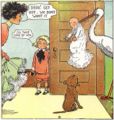
The Yellow Kid is an American comic-strip character that appeared from 1895 to 1898 in Joseph Pulitzer's New York World, and later William Randolph Hearst's New York Journal. Created and drawn by Richard F. Outcault in the comic strip Hogan's Alley, it was one of the first Sunday supplement comic strips in an American newspaper, although its graphical layout had already been thoroughly established in political and other, purely-for-entertainment cartoons. Outcault's use of word balloons in The Yellow Kid influenced the basic appearance and use of balloons in subsequent newspaper comic strips and comic books.

Moon Mullins is an American comic strip which had a run as both a daily and Sunday feature from June 19, 1923, to June 2, 1991. Syndicated by the Chicago Tribune/New York News Syndicate, the strip depicts the lives of diverse lowbrow characters who reside at the Schmaltz boarding house. The central character, Moon, is a would-be prizefighter—perpetually strapped for cash but with a roguish appetite for vice and high living. Moon took a room in the boarding house at 1323 Wump Street in 1924 and never left, staying on for 67 years. The strip was created by cartoonist Frank Willard.
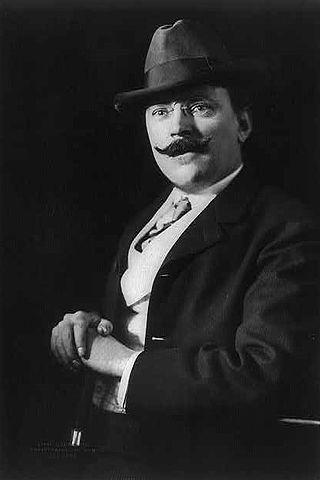
Richard Felton Outcault was an American cartoonist. He was the creator of the series The Yellow Kid and Buster Brown and is considered a key pioneer of the modern comic strip.

Rerun Van Pelt is Linus and Lucy's younger brother in Charles M. Schulz's comic strip Peanuts. Lucy Van Pelt, his sister, disparagingly calls the situation a "rerun" of the birth of her brother Linus, so Linus nicknames the child "Rerun". Despite Lucy's disappointment, she becomes a warm and protective older sister.

Mary Jane is an American term for a closed, low-cut shoe with one or more straps across the instep.
Tuckerization is the act of using a person's name in an original story as an in-joke. The term is derived from Wilson Tucker, a pioneering American science fiction writer, fan and fanzine editor, who made a practice of using his friends' names for minor characters in his stories. For example, Tucker named a character after Lee Hoffman in his novel The Long Loud Silence, and after Walt Willis in Wild Talent.
In the United States, creator ownership in comics is an arrangement in which the comic book creator retains full ownership of the material, regardless of whether the work is self-published or published by a corporate publisher.
Wee Pals is an American syndicated comic strip about a diverse group of children, created and produced by Morrie Turner. It was the first comic strip syndicated in the United States to have a cast of diverse ethnicity, dubbed the "Rainbow Gang".
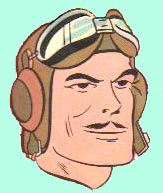
The Adventures of Smilin' Jack is an aviation comic strip that first appeared October 1, 1933, in the Chicago Tribune and ended April 1, 1973.
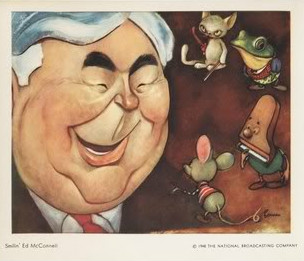
Froggy the Gremlin was a character created by Smilin' Ed McConnell and brought to radio in the 1940s and television in 1950s on the Smilin' Ed's Gang show, and later Andy's Gang TV show, hosted by actor Andy Devine after McConnell's death.

Smilin' Ed McConnell was a radio personality, best known as the host of the children's radio and television series, Smilin' Ed's Gang, closely identified with its sponsor, Buster Brown shoes, and also known as The Buster Brown Program. For his work in radio, McConnell was honored with a star on the Hollywood Walk of Fame.
This is a timeline of significant events in comics in the 1900s.
Caleres Inc. is an American footwear company that owns and operates a variety of footwear brands. Its headquarters is located in Clayton, Missouri, a suburb of St. Louis. Founded in 1878 as Bryan, Brown & Company in St. Louis, it underwent several name changes; for a time, the Hamilton-Brown Shoe Company was the largest manufacturer of shoes in America. It went bankrupt in June 1939.
Andy's Gang is a children's television program broadcast on NBC from August 20, 1955, to December 31, 1960, hosted by the actor Andy Devine. It was the successor to the radio and television program Smilin' Ed McConnell and His Buster Brown Gang. Devine took over the television program when McConnell died suddenly of a heart attack in 1954. Devine inherited a number of characters from the earlier show and the sponsor, Buster Brown shoes.

Brazilian comics started in the 19th century, adopting a satirical style known as cartoon, charges or caricature that would later be cemented in the popular comic strips. The publication of magazines dedicated exclusively to comics, in Brazil, started at the beginning of the 20th century. Brazilian artists have worked with both styles. In the case of American comics some have achieved international fame, like Roger Cruz with X-Men and Mike Deodato with Thor, Wonder Woman and others.
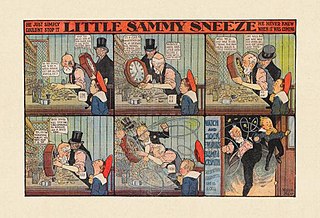
Little Sammy Sneeze was a comic strip by American cartoonist Winsor McCay. In each episode the titular Sammy sneezed himself into an awkward or disastrous predicament. The strip ran from July 24, 1904 until December 9, 1906 in the New York Herald, where McCay was on the staff. It was McCay's first successful comic strip; he followed it with Dream of the Rarebit Fiend later in 1904, and his best-known strip Little Nemo in Slumberland in 1905.
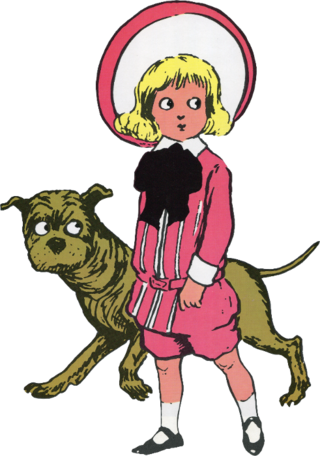
A Buster Brown suit was a very popular style of clothing for young boys in the United States during the early 20th century. It was named after the comic strip character Buster Brown, created in 1902 by Richard Felton Outcault.
Tige is a masculine given name and nickname which may refer to:
The New York World was one of the first newspapers to publish comic strips, starting around 1890, and contributed greatly to the development of the American comic strip. Notable strips that originated with the World included Richard F. Outcault's Hogan's Alley, Rudolph Dirks' The Captain and the Kids, Denys Wortman's Everyday Movies, Fritzi Ritz, Gus Mager's Hawkshaw the Detective, Victor Forsythe's Joe Jinks, and Robert Moore Brinkerhoff's Little Mary Mixup.








